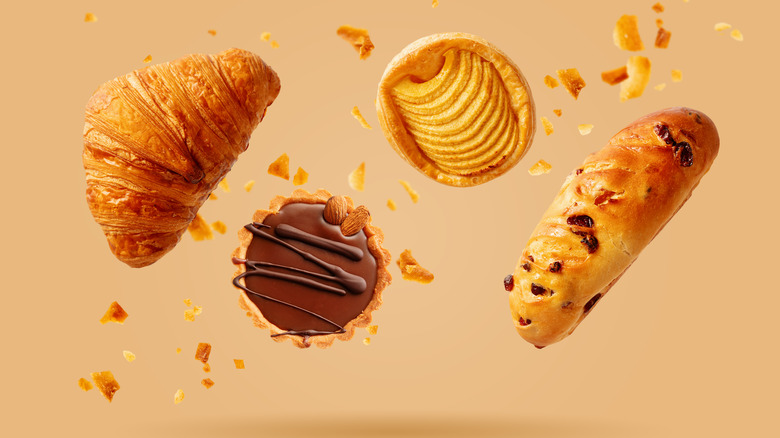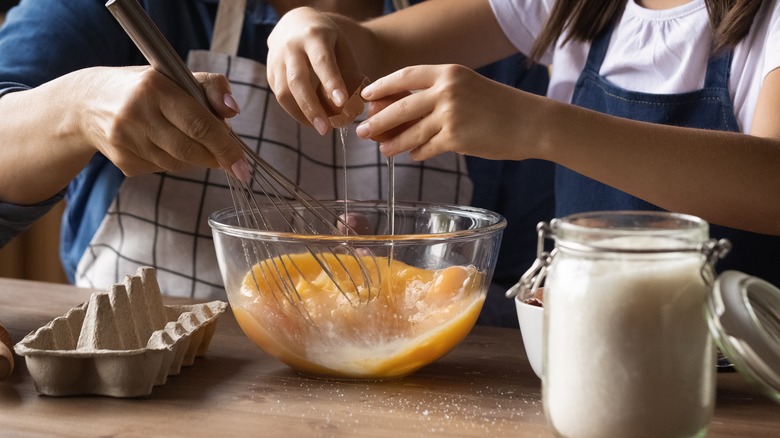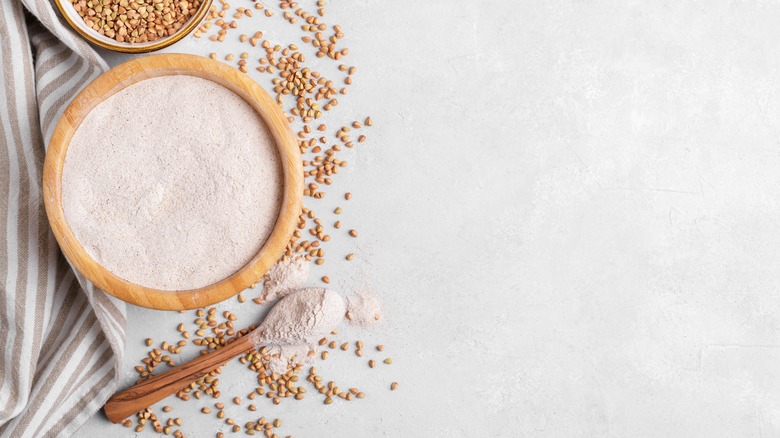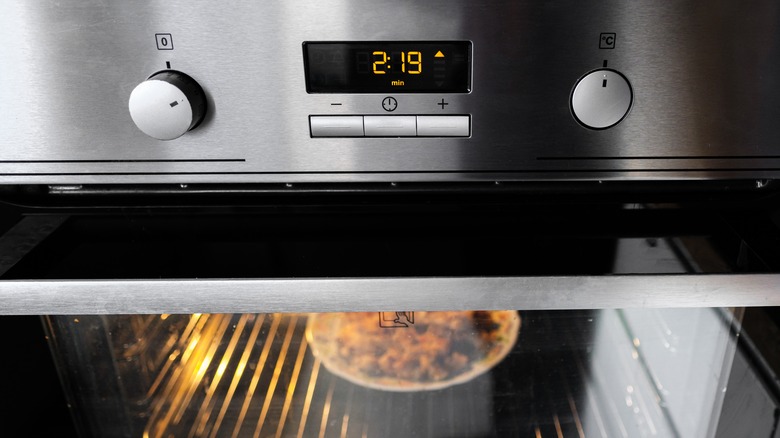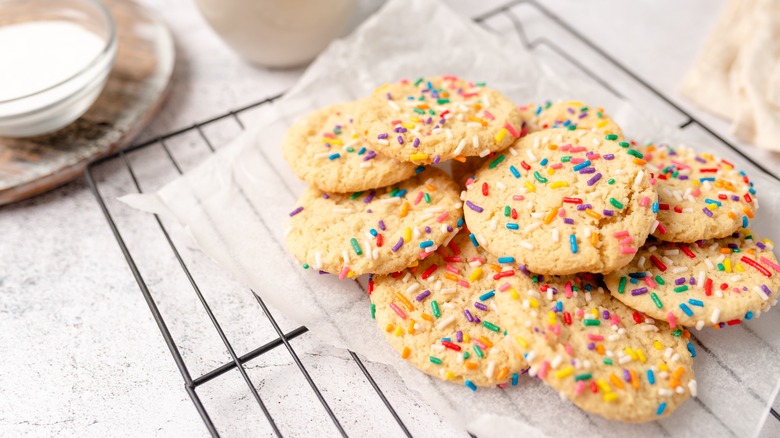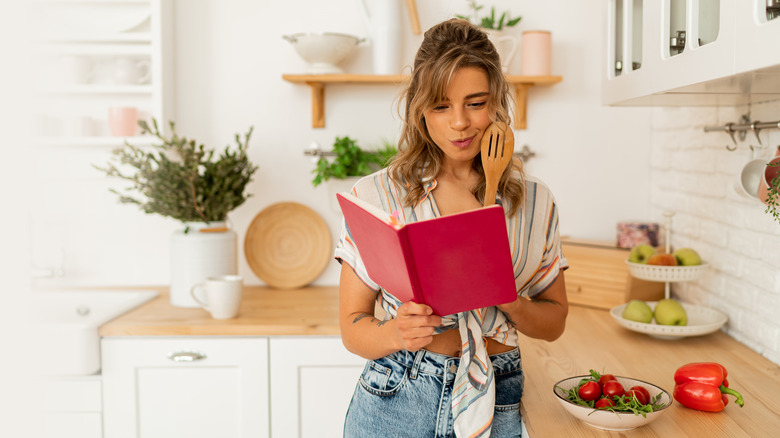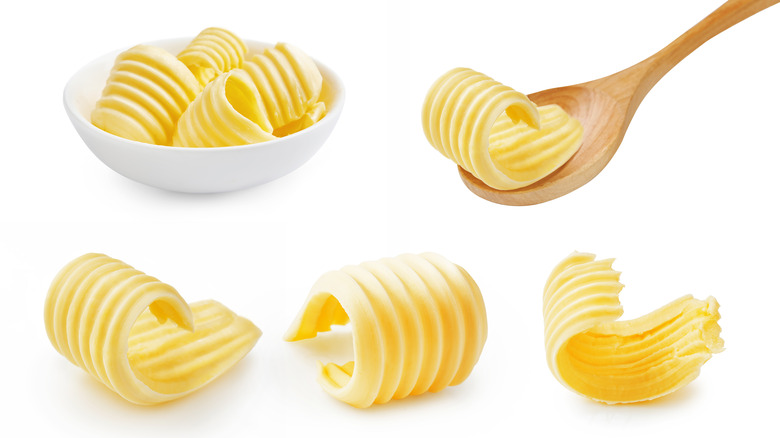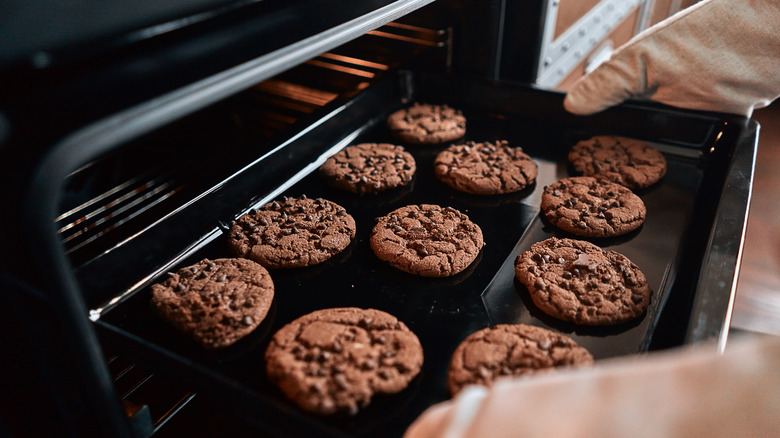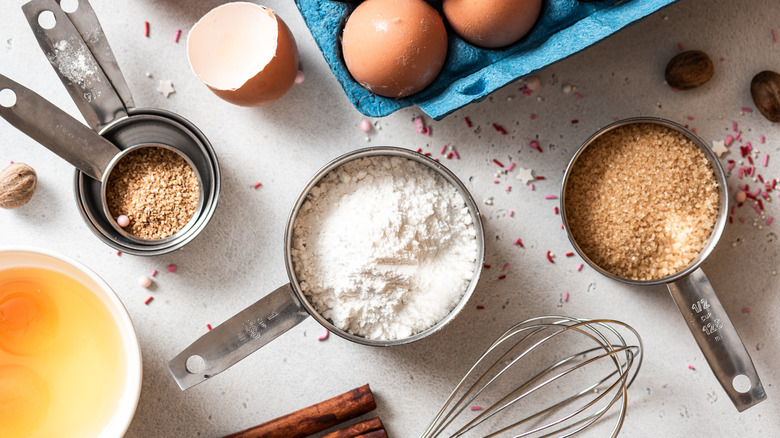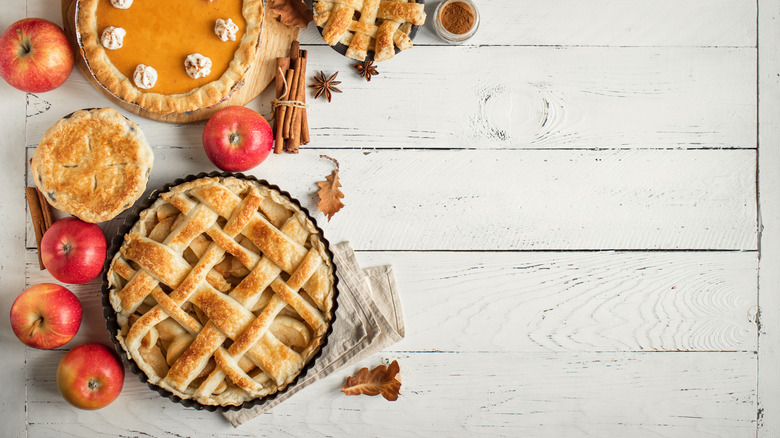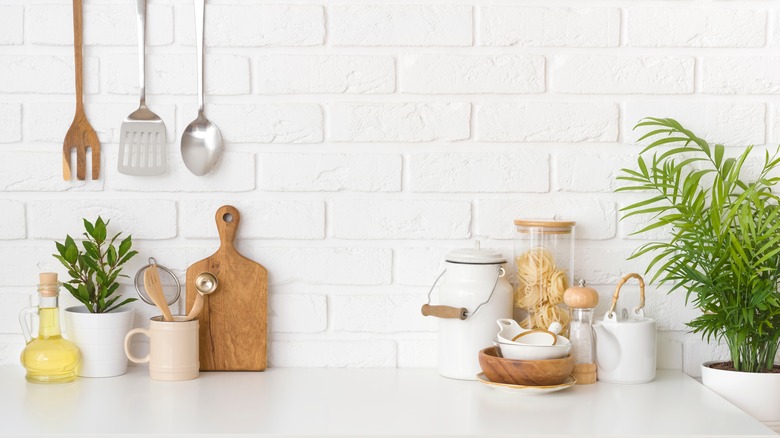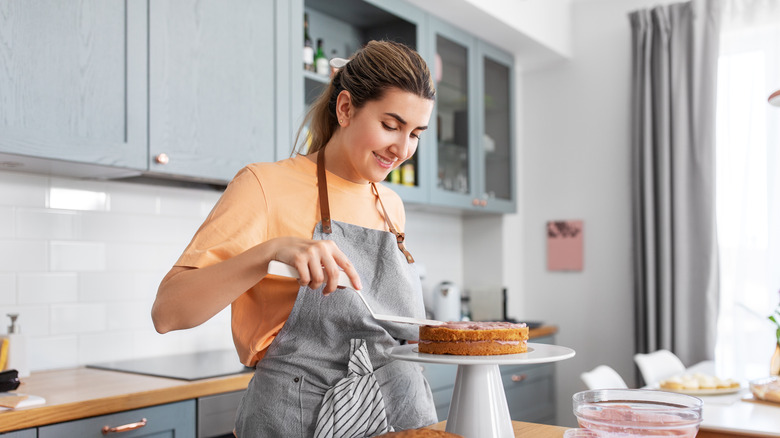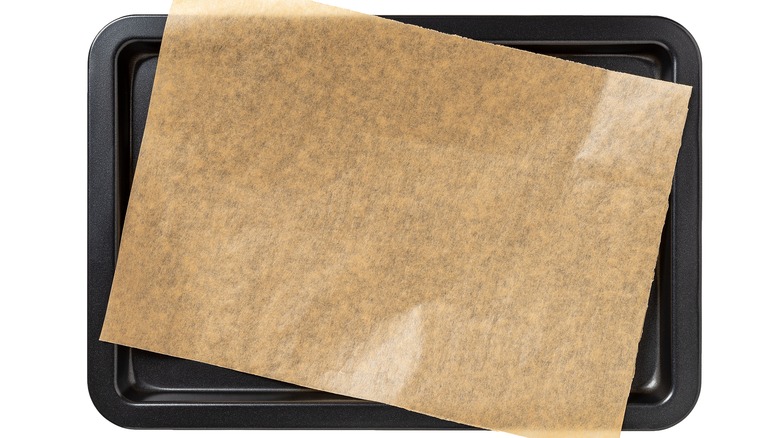12 Prepping Tips You Need Before You Even Start To Bake
We may receive a commission on purchases made from links.
Baking is a science. When you're cooking, you can taste as you go, season as needed, and adjust the recipe to your liking, but when you're baking, there are rules that you need to follow. If your bakes are not turning out as planned, there are probably some big mistakes you're making while baking.
The art of baking dates back thousands of years, all the way back to ancient Egyptians, who invented the oven, according to Britannica. Since then, baking has evolved to encompass a huge variety of different types of pastry, including cakes, breads, pies, rolls, and muffins. While baking can be intimidating at first, there is nothing like fresh baked goods made in your own kitchen.
However, preparation is essential. That's why it's so important to follow some essential tips and tricks when baking. Soon, you'll be making perfect pies and majestic muffins in no time. So happy baking!
1. Keep wet ingredients at room temperature
When you're cooking, you don't really need to think about the temperature of your ingredients while you're preparing them. On the other hand, most recipes that you use when baking will specify the temperature of your ingredients. And there is a reason they do. If your cakes and pies are not turning out as planned, you may want to make sure your ingredients are at the right temperature.
Some recipes are more forgiving than others. According to Baker Bettie, muffins and quick breads might not be ruined by cold ingredients, but if you're making anything that requires a cohesive dough or batter, or anything that won't end up with a flaky texture at the end, you'll want your ingredients at room temperature. This rule only applies to wet ingredients like eggs, butter, and other dairy products.
Wet ingredients mix together more readily at room temperature, which leads to a creamier batter and a tastier final product. You'll want to leave your wet ingredients outside the fridge for about an hour before you begin baking, or long enough so that they are at about 70 degrees Fahrenheit when you start mixing. To speed up the process, you can also get eggs to room temperature by leaving them in a bowl of warm tap water for about five minutes, depending on how many eggs you're using.
2. Learn to measure your flour
Baking requires precision. And it turns out there is a right and wrong way to measure flour, which is one of the most common ingredients in baked goods. If your cakes are turning out too crumbly, soft, or dry, chances are you're not measuring out your flour properly. According to the blog Love and Lemons, if you're dipping your cup measure into a bag of flour, you're doing it all wrong.
The best way to properly measure flour for perfect cakes is to use a scale. If your recipe states the weight of the flour required, then adhere to that, although measurements are more often described as a volume measure in cups. According to King Arthur Baking, a cup of flour contains about 120 grams.
If you don't have a scale on hand, the next best thing you can do is fluff your flour before you measure it out. This is done by using a large spoon or rubber spatula to stir the flour around until it no longer looks compact (as per Baking Kneads). Then, instead of dipping the measuring cup into the flour, spoon the flour into the measuring cup and then level it off with a butter knife.
3. Buy an oven thermometer
When you preheat your oven to make a perfect batch of cookies, it's important to be sure that it's at the right temperature. Though the digits on the oven may read 350 degrees Fahrenheit, the question remains: Can you actually trust a built-in oven thermometer? According to Martha Stewart, most built-in oven thermometers are off by as much as 50 degrees, which is a recipe for burnt cookies, soggy pie crusts, and a whole host of baking follies.
Luckily, there is a workaround. You can buy an oven thermometer, which won't set you back more than about $5-$15, and they're easy to find in cooking stores or on Amazon. Unlike the digital reading on your oven, which remains constant after you set it, the oven thermometer's reading will change with the temperature of the oven, so you can be sure exactly how hot it is.
According to MasterClass, the best way to use an oven thermometer is to place it in the middle of the oven and give it a read once the oven is preheated. If there is a discrepancy between the temperature on the built-in thermometer and the oven thermometer, you can adjust the temperature accordingly.
4. Chill cookie dough before baking
Cookies are a baking classic. A perfect plate of freshly baked cookies is nothing short of magic. But to get that perfect taste and texture, you should always chill sugar cookie dough overnight. Cookie dough contains butter, and if your butter melts faster than your cookie bakes, your dough will spread and you'll end up with flat, thin, greasy puddles instead of plump, full, perfect cookies, according to Sally's Baking Addiction.
So when you're done preparing cookie dough, pop it in the fridge before you form the cookies and put them in the oven. While you should really leave the dough in the refrigerator overnight to make sure the cookies won't spread on the pan, if you're tight on time, you should refrigerate the dough for at least thirty minutes. If you leave the dough in the fridge overnight and it gets too hard to form it into cookies, just let it rest for about ten minutes before you start working with it.
5. Read through the whole recipe before you start
Hold your horses! Before you even start measuring out your ingredients for a recipe that you want to bake, make sure you read through the whole recipe, so you have a good understanding of the process. Baking recipes can get complicated, and baking is a process that shouldn't be rushed.
Sometimes, ingredients listed in a recipe are divided into different steps and introduced into the recipe at different times, which is crucial knowledge to have before you start a bake. When you're making recipes like pumpkin pie, it's important to turn the oven temperature down at a certain point while it's baking.
Also, reading through a whole recipe before you start ensures that you have all of the correct ingredients ready to go so that you don't have to take any unnecessary pauses during the time-sensitive baking process. Also, according to Anderson and Grant, water sometimes isn't listed in the ingredients list, but it shows up in the body of the recipe, which is important to know beforehand so that no surprises come up.
6. Make sure your butter is at the correct consistency
Everything is better with butter, especially when it comes to baking. Not only does butter have a famously irresistible flavor, but it has a dynamic texture that has the power to make the perfectly flaky pie crust or a light, fluffy cake. But it's important to remember that there are tips that you need when cooking with butter, and one of the most important ones when it comes to baking is the temperature of the butter before it interacts with the other ingredients.
Most recipes will specify what temperature your butter needs to be. When a recipe calls for butter at room temperature, it's important to know what that means. According to Sally's Baking Addiction, room temperature butter should be about 65 degrees Fahrenheit. To achieve this temperature, you should aim to leave your butter out for about 1-2 hours before you start baking.
To test whether your butter is at the correct temperature and consistency, push your finger into it. If your finger makes an indent without sliding or sinking into the butter, it is good to go. On the other hand, for pie crusts, using cold butter doesn't with the other ingredients in the dough, ensuring a nice, flaky texture, according to Quartz.
7. Know how to grease your pan
One important part of the baking process that is often overlooked is greasing your pan. You can spend hours slaving over a perfectly moist zucchini bread or deliciously delicate cupcakes only to have them stick to the tin, resulting in a crumbly mess, which is why it's crucial to know the best ways to prepare a pan for baking. There are a few methods that we stand by.
For cast iron cookware, it's best to use a combination of flour and butter, according to The Kitchn. Using parchment paper to line baking sheets is also a great way to prevent sticking. You can also use a variety of other items and ingredients you may have around the house.
Coconut oil and cocoa powder are two great pan preparation options for vegan bakers. Using aluminum foil is not only a great way to easily lift a delicious treat from a pan, but you can also use it to shape a cake if you're looking to add some extra flair to your baked goods.
8. Stock your kitchen with basic ingredients
If you want to start baking, there are some basic ingredients that you need to have on hand. Obviously, sugar is crucial in baking, as are flour and baking soda, and you'll want to have these ingredients ready to go in your kitchen so that you can get right to baking your favorite treats.
For the seasoned baker, there are more ingredients beyond just the basics that you might want to think about keeping in your pantry, according to Brown Eyed Baker. These include different types of flour like bread flour, cocoa powder, vanilla extract, brown sugar, and powdered sugar, to name a few.
But even for the most occasional baker, you'll always want to have all-purpose flour ready to go in your kitchen because flour is one of the most common ingredients used in baking recipes. You can store all-purpose flour in an air-tight container in your pantry, and it will last for up to a year, according to Healthline.
If you don't bake as often, you should refrigerate flour, especially if you live in a warm, humid climate. If you try this method, Masterclass suggests you let the flour sit out until it reaches room temperature before you start to bake with it.
9. Weigh your pie crust down when blind baking
There's nothing like pie. But the sweet, luscious fruit filling needs an equally delicious, flaky, buttery crust in order for the dessert to really shine. You may notice that many recipes call for "blind baking" a pie crust before the filling, which means baking the crust before putting in the filling. And in order to achieve the perfect crust, it's essential to weigh down your pie crust when blind baking.
According to KitchenAid, weighing down your pie crust while it's in the oven helps retain the shape and size of the crust; otherwise, it can pull away from the edges of the tin and form air bubbles. Pie weights are easy to find at kitchen supply stores, and they're usually made of ceramic or metal (as per Web Restaurant Store).
But if you don't have pie weights, there are many handy alternatives that you can use that you might have in your kitchen already. You can use dry beans, uncooked rice, or even loose change to weigh down your pastry. Just note that after you bake beans or grains in the oven, they won't cook properly, so they should be reserved for this purpose.
10. Make sure you have the proper tools
Using tools is what sets us apart from animals. And when you're baking, it becomes abundantly clear why: You can't achieve a perfect bake without a proper set of tools. And there are some essential tools every kitchen must have in order to start baking.
While some staples like baking pans, cupcake tins, oven mitts, and measuring cups are obvious necessities in any foodie's kitchen, there are some kitchen tools that you'll want to keep stocked if you want to create bakes that really have that wow factor.
A pastry brush, for instance, is usually made of silicon or wood: It has natural bristles, and it is a must-have for coating bakes evenly with melted butter or egg whites, according to Martha Stewart.
For those looking to master the art of bread making, the baking tool that will give you a crispier bread crust is a baking stone (sometimes known as a pizza stone), which is a rectangular block of stone or ceramic that helps evenly heat your bread and give you that perfect crust (via The Kitchn).
11. Know how to double a recipe properly
When you're baking, it's tempting to go ahead and double a recipe. You're already in the kitchen doing all the work, so you might as well just go ahead and make twice as many cookies or muffins and save them for later, right? While we totally support making more food, you should know how to properly double (or triple) a recipe before you start baking.
Baking is a science, and when you're doubling a recipe, it changes the way the ingredients interact. What show host and all-around food and entertaining guru Ina Garten does before doubling a recipe is adjusting the ingredients as she scales the recipe up.
According to The Kitchn, doubling cookies, bars, bread, and rolls doesn't usually require much adjustment, but when you're making muffins, cakes, and quick breads, you need to be mindful about the amount of leavener you're using. Instead of simply doubling the amount of baking powder or baking soda listed in the recipe, use one or 1 and a quarter teaspoons of baking powder and one-quarter teaspoon of baking soda per cup of all-purpose flour.
12. Use parchment paper
There are a variety of items that bakers use to create perfect confections, and one of the handiest is parchment paper. While it comes in rolls, you can cut parchment paper to fit almost any pan or buy pre-cut sheets that fit many standard sizes of baking sheets, and it's a great way to prevent baked goods from sticking to tins and cookie sheets.
The beautiful thing about parchment paper when it comes to baking is that it can withstand relatively heat, up to 450 degrees Fahrenheit, according to Martha Stewart. So while you can't use it under a broiler, it's good for almost any baking application.
Because parchment paper comes in rolls, it often curls when you put it on a baking sheet. So another great tip that you need when cooking with parchment paper is to crumple up the paper before you place it on the sheet to prevent it from curling. If you're in a pinch, you can roll a piece of parchment into a makeshift pastry bag, according to Kelly Senyei. Whatever your needs, parchment paper is a baker's best friend.
